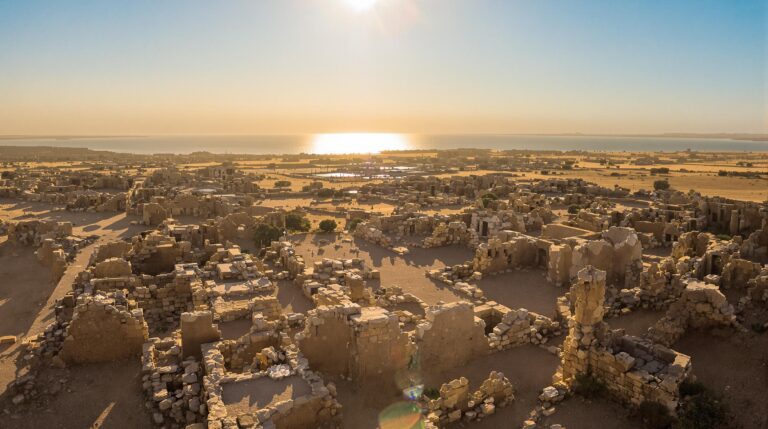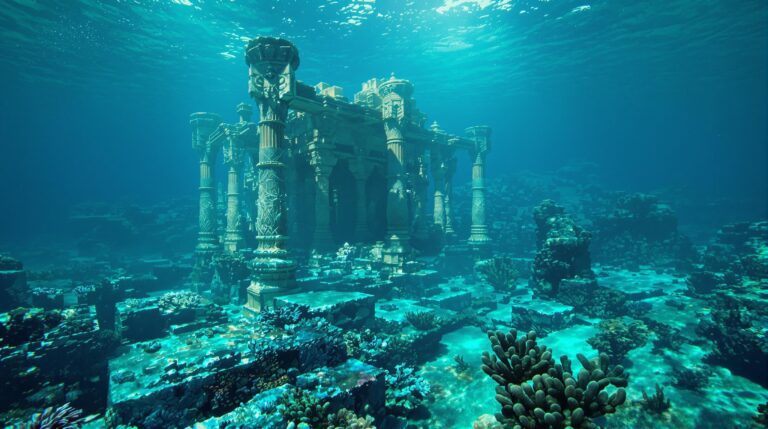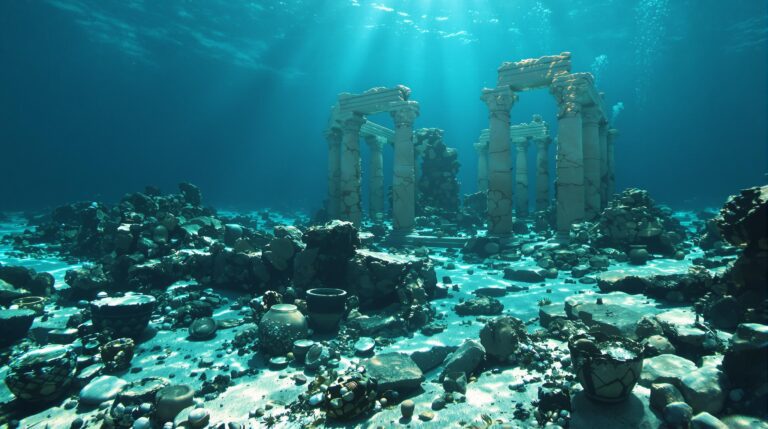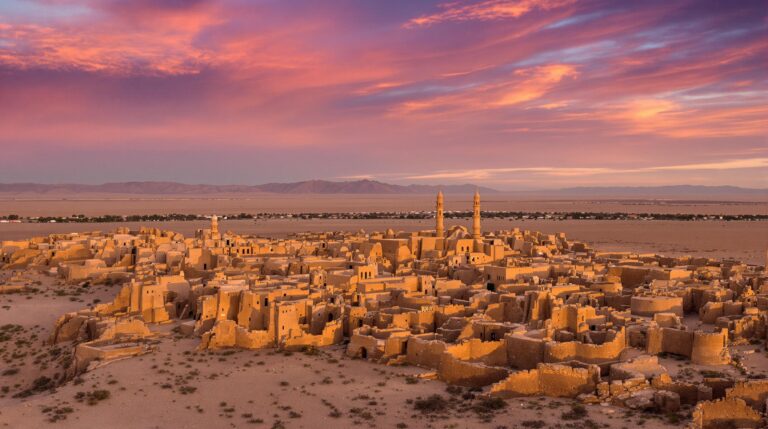Troy: Separating Myth From Reality
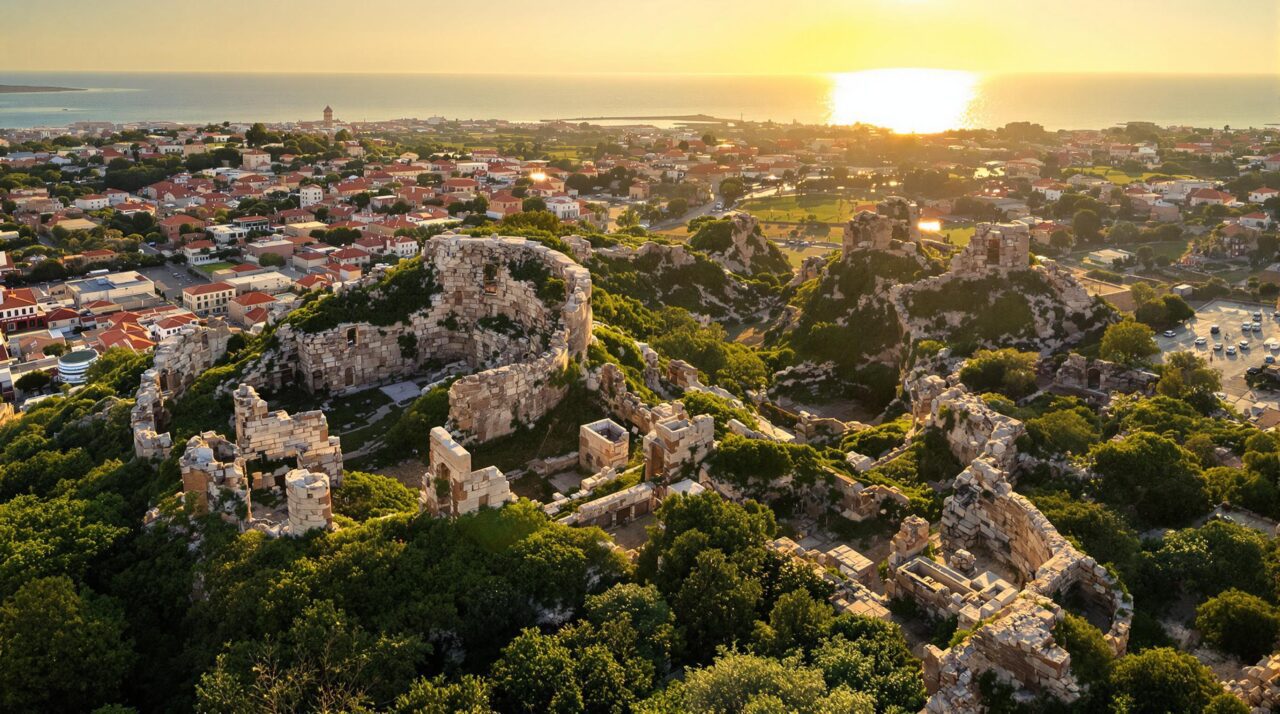
The story of Troy captivates scholars and enthusiasts alike. It intertwines myth with potential historical truths, challenging perceptions of ancient narratives.
Archaeological findings, such as remnants of walls and signs of destruction, offer intriguing insights.
Yet, the question persists: how much of Troy’s tale is rooted in fact?
This exploration reveals complex layers of cultural identity and memory, prompting a deeper inquiry into the stories that define civilizations.
What emerges from this intersection of history and legend?
TL;DR
Hide- Archaeological evidence, such as fortifications and burn layers, suggests a historical conflict aligning with the legendary tales of Troy and the Trojan War.
- The blending of cultural artifacts from Aegean, Anatolian, and Hittite civilizations illustrates Troy's role as a significant trading hub and cultural exchange center.
- Hittite records mentioning a city named Wilusa indicate a historical basis for the Troy myth, although its exact relation remains debated among scholars.
- Homer's "The Iliad" merges myth and history, shaping perceptions of heroism and morality while blurring the lines between factual events and legendary narratives.
- The ongoing exploration of Troy highlights the importance of ethical stewardship in archaeology, balancing the pursuit of truth with respect for cultural heritage.
The Tale of Troy and the Trojan War That Shaped Western Storytelling
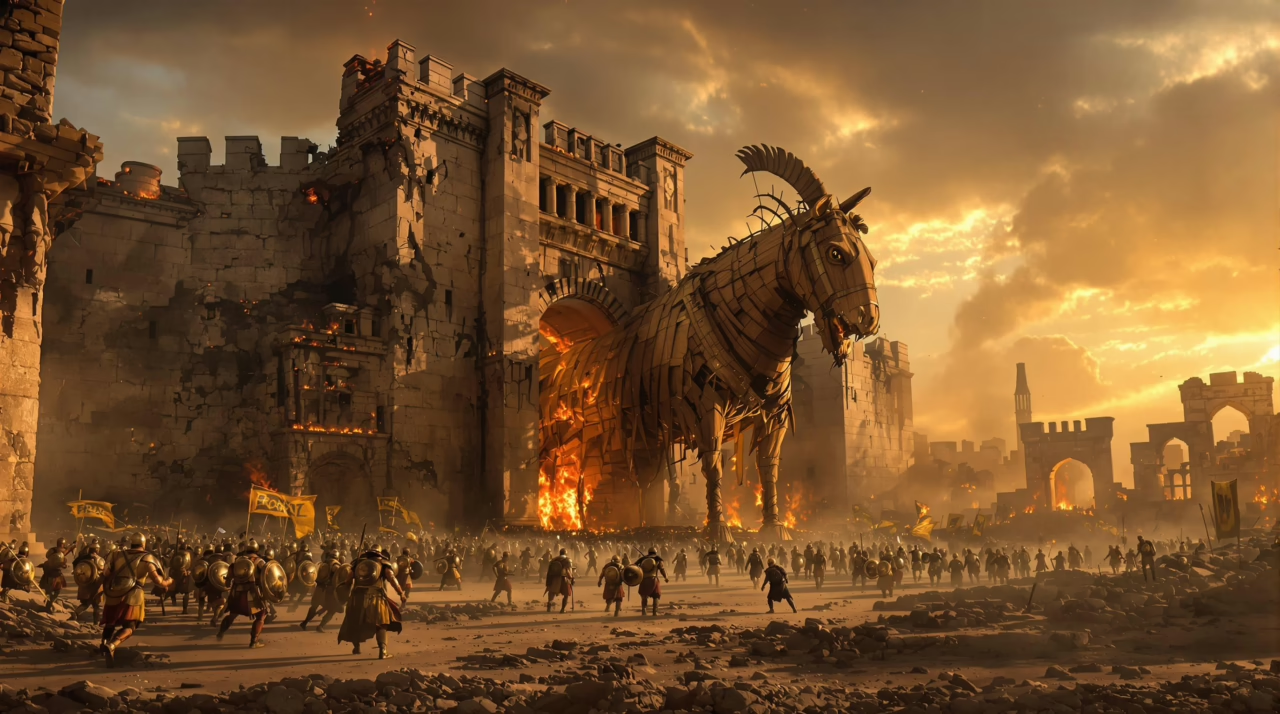
The tale of Troy, immortalized in Homer’s “The Iliad,” serves as a cornerstone of Western storytelling, illustrating timeless themes of heroism, honor, and the human condition.
Central to this narrative is the enigmatic Trojan Horse, a symbol of cunning and deceit that continues to resonate in contemporary discourse.
Together, these elements not only reflect ancient values but also shape the narrative frameworks that influence literature and culture to this day.
The Iliad and the Legend of Troy
Homer’s “The Iliad” serves as a cornerstone of Western literature, intertwining the fates of gods and mortals in a narrative that explores the complexities of honor, heroism, and the brutal realities of war.
This epic not only reflects the cultural values of ancient Greece but also establishes archetypes that resonate through countless stories across generations.
The interplay between divine intervention and human agency in the Trojan War invites a deeper examination of how these themes have shaped storytelling traditions throughout history.
Homer’s Epic as Cultural Foundation
While the epic tales of ancient Greece often blur the lines between history and myth, the significance of the Trojan War and its portrayal in the Iliad remains a cornerstone of Western literary tradition.
This narrative not only encapsulates the complexities of human experience but also serves as a cultural touchstone, influencing storytelling, themes of heroism, and moral inquiries throughout history and into contemporary literature.
Gods, Heroes, and the Drama of War
In ancient narratives, the interplay of gods and heroes serves as a critical lens through which the trauma and glory of war are examined, particularly in the context of the Trojan War.
Divine interventions complicate human motivations, while legendary figures embody ideals and flaws, reflecting the chaotic nature of conflict.
This complex relationship between mortals and deities ultimately shapes the enduring legacy of Western storytelling.
The Trojan Horse and Its Symbolic Power
The story of the Trojan Horse raises intriguing questions regarding the nature of cunning in warfare and storytelling.
As both a clever ruse and a potential literary invention, it embodies themes of deception and ingenuity that resonate throughout history.
Its enduring presence in cultural narratives invites reflection on why such tales continue to captivate audiences, shaping perceptions of strategy and heroism.
A Clever Ruse or Literary Invention?
Although the story of the Trojan Horse has captivated audiences for centuries, its origins raise questions about the boundaries between historical fact and literary invention.
Scholars debate whether it represents a clever military strategy or a narrative device crafted to explore themes of deception and cunning. This dichotomy invites deeper reflection on how myths evolve, shaping collective memory and influencing contemporary storytelling.
Why This Part of the Story Endures
While the tale of the Trojan Horse may have its roots in ancient myth, its enduring impact on Western storytelling stems from the powerful themes of cunning, betrayal, and the unforeseen consequences of war.
This narrative not only captivates through its dramatic irony but also serves as a cautionary tale, reminding audiences of the fragility of trust and the potential for deception in human endeavors.
Troy and the Trojan War: What the Evidence Says
Archaeological discoveries continue to illuminate the complex narrative surrounding Troy and the legendary Trojan War. Scholars have unearthed artifacts and remnants that suggest a blend of myth and reality, prompting a reevaluation of historical accounts.
Key findings include:
- Fortifications: The impressive walls of ancient Troy indicate a society capable of significant military endeavors.
- Destruction Layers: Evidence of violent destruction points to a conflict, possibly aligning with the tales of a great war.
- Cultural Artifacts: Items such as pottery and inscriptions reveal interactions with other civilizations, suggesting a rich cultural exchange that may have influenced the mythos.
These elements invite deeper exploration into the veracity of Homer’s accounts, challenging historians to discern fact from fiction in the epic saga of Troy.
Searching for the Real Troy
The quest for the real Troy has been marked by significant controversies, particularly surrounding Heinrich Schliemann’s excavation methods and findings.
His claims sparked debates about the authenticity of the site, while subsequent research revealed multiple layers of settlements beneath the surface, complicating the narrative of a singular heroic city.
This multifaceted archaeological landscape raises critical questions about the intersection of myth and historical reality in understanding Troy’s legacy.
Heinrich Schliemann’s Excavation Controversy
Heinrich Schliemann’s excavations at the site believed to be ancient Troy have sparked significant debate regarding their impact on archaeological integrity versus the pursuit of fame and fortune.
While Schliemann unearthed substantial artifacts that captivated the public imagination, his methods often resulted in the destruction of critical layers of historical context.
This raises essential questions about the balance between treasure hunting and scientific discovery in the domain of archaeology.
Treasure Hunting or Scientific Discovery?
While many view Heinrich Schliemann as a pioneering archaeologist, his methods have sparked intense debate over whether his pursuits were driven by genuine scientific inquiry or the allure of treasure hunting.
Critics often highlight:
- The prioritization of artifacts over stratigraphy.
- The sensationalism surrounding his discoveries.
- The ethical implications of his excavation techniques.
These factors complicate the narrative of Schliemann as a true scientific innovator.
What He Found and What He Destroyed
Excavating the layers of Troy, Schliemann unearthed a trove of artifacts that sparked excitement and controversy alike.
His findings, including gold jewelry and pottery, ignited debates about historical accuracy and authenticity.
However, his aggressive excavation methods led to the destruction of critical layers, obscuring the timeline of Troy’s civilizations.
This juxtaposition raises questions about the ethics of archaeological exploration and the pursuit of truth.
Multiple Cities Beneath the Surface
The archaeological site of Troy reveals a complex tapestry of civilizations, with layers designated as Troy I through Troy IX, each representing distinct historical periods.
This stratification raises critical questions about which layer, if any, corresponds to the city immortalized by Homer.
As scholars sift through the remnants of these successive settlements, they grapple with the challenge of reconciling mythic narrative with tangible evidence.
Troy I to Troy IX: Layers of History
Nine distinct layers of settlement, known as Troy I through Troy IX, reveal the complex tapestry of human habitation at the site of ancient Troy.
Each layer embodies unique cultural, architectural, and societal characteristics that reflect the evolution of civilization.
Key insights include:
- Architectural advancements over time.
- Shifts in trade and economy.
- The continuity of human resilience.
These layers collectively narrate Troy’s historical significance.
Which Layer Matches Homer’s Troy?
Identifying the layer of Troy that corresponds with the legendary city depicted in Homer’s epics has long intrigued historians and archaeologists.
While many point to Troy VII as a likely candidate due to its fortifications and destruction layer, others consider Troy VI, known for its wealth and influence, as a strong contender.
The debate continues, reflecting the complexities of intertwining myth and archaeological evidence.
Evidence of War and Catastrophe
Archaeological findings at the site of ancient Troy reveal a complex tapestry of destruction, characterized by layers of ash and evidence of violent conflict.
The presence of advanced weaponry, coupled with robust city walls and strategic urban design, suggests that the inhabitants faced significant threats, potentially from siege warfare.
This convergence of material evidence raises critical questions about the historical realities that may have inspired the legendary tales of the Trojan War.
Burn Layers and Signs of Siege
The archaeological evidence from Troy VI and VII presents a compelling narrative of destruction marked by distinct burn layers and signs of siege.
Scholars debate whether these layers are indicative of catastrophic earthquakes or the aftermath of invasion, each theory offering different insights into the fate of this storied city.
Understanding these elements not only sheds light on the events that led to Troy’s downfall but also challenges the boundaries between myth and historical reality.
Archaeological Clues from Troy VI and VII
While the legends of Troy have captivated imaginations for centuries, the tangible remnants of Troy VI and VII offer a more sobering narrative steeped in evidence of conflict and destruction.
Key archaeological findings reveal:
- Distinct burn layers indicating intense fires.
- Structural damage suggesting siege activities.
- Abandonment patterns reflective of societal collapse.
These clues provoke questions about the realities that shaped Troy’s fate beyond myth.
Earthquakes or Invasion: What Caused the Ruin?
What ultimately led to the downfall of Troy? Scholars debate between natural disasters and human conflict.
Archaeological evidence reveals burn layers and signs of siege, suggesting a violent invasion. Conversely, seismic activity might explain structural collapses.
The intertwining of these factors raises questions about human resilience and vulnerability, inviting reflection on how societies respond to both natural and man-made catastrophes, ultimately shaping their destinies.
Weaponry, Walls, and City Design
The architectural fortifications of Troy serve as a demonstration of the city’s strategic importance and the persistent threats it faced.
An analysis of the defensive walls and weaponry artifacts reveals not only the technological advances of the time but also the societal structures that prioritized military readiness.
These elements collectively illuminate the intricate relationship between urban design and the realities of warfare in ancient Troy.
Defensive Architecture and Warfare Artifacts
Defensive architecture and warfare artifacts reveal the complexities of conflict and survival in ancient Troy, underscoring the city’s strategic significance in the Aegean world.
Key elements include:
- Massive city walls, designed to withstand sieges.
- Sophisticated weaponry, indicating advanced military technology.
- Urban planning that facilitated both defense and daily life.
These features collectively illustrate Troy’s resilience in the face of relentless threats.
What the Fortifications Reveal
Resilience in the face of adversity is poignantly illustrated through the remnants of Troy’s fortifications, which offer critical insights into the city’s tumultuous history.
The robust walls and strategically designed gates reveal a society prepared for conflict, while the presence of weaponry underscores a relentless struggle for survival.
These elements collectively narrate a tale of endurance amidst chaos, shaping Troy’s enduring legacy.
Trade, Wealth, and Strategic Location
Troy’s geographical position made it a pivotal hub for trade, facilitating the flow of goods and ideas between varied cultures.
This strategic location not only bolstered its wealth but also fostered a unique environment for cultural blending, essential for a city at the crossroads of civilizations.
Understanding Troy’s role as a commercial power invites a reevaluation of its historical significance beyond mere legend.
Troy as a Commercial Power
Troy’s strategic position at the crossroads of the Dardanelles allowed it to control essential maritime routes, establishing its significance as a commercial hub in the ancient world.
The city’s wealth was further amplified by its access to luxury goods, which connected it to a vast network of trade across the Bronze Age.
This interplay of location and commerce not only enhanced Troy’s economic power but also contributed to its enduring legacy in both history and myth.
Controlling the Dardanelles and Maritime Routes
Although often romanticized in legend, the strategic significance of Troy’s location near the Dardanelles reveals a complex interplay of trade, wealth, and military power that shaped its historical prominence.
Key factors include:
- Control over maritime routes essential for trade.
- Enhanced economic prosperity through taxation of passing vessels.
- Military advantage in securing regional dominance.
These elements underscore Troy’s pivotal role in ancient commerce and geopolitics.
Luxury Goods Linking Troy to the Bronze Age World
While the allure of luxury goods often captivates the imagination, their role in connecting Troy to the broader Bronze Age world reveals a sophisticated network of trade that was fundamental to the city’s prosperity.
This strategic location facilitated the exchange of precious metals, textiles, and ceramics, enhancing Troy’s economic stature and cultural influence, thereby establishing it as a pivotal commercial power in the ancient world.
Cultural Blending in a Borderland City
Troy’s strategic location at the crossroads of the Aegean and Anatolian worlds facilitated a remarkable cultural blending, evidenced by the confluence of Aegean, Anatolian, and Hittite influences.
Artifacts such as scripts, seals, and ceramics reveal a diverse mosaic of interactions, reflecting the city’s role as a lively trade hub.
This amalgamation not only enhanced Troy’s material culture but also fostered a unique identity that transcended regional boundaries.
Aegean, Anatolian, and Hittite Influences
Frequently regarded as a crossroads of ancient civilizations, Troy exemplified the dynamic interplay of Aegean, Anatolian, and Hittite cultures.
This cultural blending fostered a unique environment characterized by:
- Trade Networks – Facilitating exchange of goods and ideas.
- Wealth Accumulation – Enabling the city to flourish economically.
- Strategic Location – Serving as a pivotal military and cultural hub.
Troy’s legacy reflects a tribute to interconnectedness in antiquity.
Scripts, Seals, and Ceramics in the Troy Region
Artifacts such as inscribed clay tablets, intricate seals, and distinctive ceramics provide valuable insights into the cultural dynamics of the Troy region.
These objects reveal a tapestry of trade and wealth, illustrating how diverse influences converged in this strategic location. The blending of styles and scripts reflects not only economic exchanges but also the rich interplay of identities and ideas among ancient civilizations.
Troy in the Eyes of Ancient Empires
The city of Troy, known as Wilusa in Hittite records, presents a fascinating intersection of historical fact and cultural memory across ancient empires.
Greek narratives immortalized its legendary status, while Roman interpretations adapted these myths to fit their own imperial identity.
Analyzing these perspectives reveals how Troy’s legacy evolved, reflecting the shifting values and aspirations of civilizations that sought to define themselves through its storied past.
Hittite Records and the City of Wilusa
Hittite records offer a fascinating glimpse into the political landscape of the ancient Near East, particularly through their diplomatic letters that reference a city known as Wilusa.
Scholars have long debated whether this city is synonymous with the legendary Troy, raising questions about the historical accuracy of the epic narratives.
The interplay of political tensions and territorial claims in these texts invites a reevaluation of both Wilusa’s identity and its significance in the broader context of Hittite diplomacy.
Diplomatic Letters and Political Tensions
Ancient diplomatic correspondence reveals the intricate web of political tensions surrounding the city of Wilusa, often identified with the legendary Troy.
These letters illustrate:
- The strategic importance of Wilusa in Hittite relations.
- The rivalry between empires vying for dominance in the region.
- The complexities of alliances influenced by trade and military needs.
Such dynamics underscore the significance of Wilusa beyond myth.
Is Wilusa the Historical Troy?
How can one discern the historical reality of Wilusa amidst the layers of myth and legend associated with Troy?
Hittite records suggest a significant connection between Wilusa and the famed city, hinting at a shared cultural and geopolitical landscape.
Greek Memory and Roman Adoption
Troy’s significance transcended its geographical confines, becoming a pivotal element in the mythological narrative that shaped Rome’s identity.
Through the figure of Aeneas, the city not only served as a foundation for Roman heritage but also symbolized the continuity of power from fallen civilizations.
This intertwining of Greek memory and Roman adoption reveals how myth can be repurposed to construct legitimacy and cultural pride in a new context.
Troy’s Role in Founding Rome through Aeneas
While the epic narrative of Aeneas serves as a bridge between Greek and Roman cultures, it also encapsulates the profound mythological significance attributed to Troy in the founding of Rome.
- Aeneas symbolizes resilience in the face of destruction.
- The journey from Troy to Italy reflects cultural continuity.
- Troy’s legacy legitimizes Roman identity and aspirations.
Troy as a Symbol of Heritage and Power
Heritage resonates deeply within the ancient narratives of Troy, serving as a powerful emblem for both Greek and Roman civilizations.
For the Greeks, Troy epitomized valor and tragedy, while the Romans adopted its legacy to establish their own cultural identity.
This duality illustrates how Troy transcended mere legend, embodying themes of resilience and power that continue to inspire contemporary discourse on heritage and identity.
Myth, Memory, and Modern Identity
The enduring resonance of Troy in contemporary culture underscores the intricate relationship between myth and identity.
As modern societies grapple with their historical narratives, the lessons drawn from the intersection of myth and archaeology reveal how these stories shape collective memory.
This dynamic interplay not only informs personal identities but also influences broader cultural understandings of heritage and legacy.
Why Troy Still Resonates Today
The enduring legacy of Troy in literature and cinema highlights a collective fascination with heroic tragedy and the complexities of human identity.
As contemporary narratives reimagine this ancient tale, they reveal not only the timeless nature of conflict and honor but also the universal themes that resonate across cultures.
This ongoing engagement with Troy invites reflection on how myth shapes modern identity and influences societal values today.
Literature, Cinema, and Reimagining the Past
While many ancient tales have faded into obscurity, the story of Troy continues to captivate modern audiences through literature and cinema, illustrating the enduring power of myth.
This phenomenon can be attributed to:
- The timeless themes of love and betrayal.
- The exploration of heroism and sacrifice.
- The reinterpretation of identity and cultural memory.
These elements guarantee that Troy remains relevant in contemporary discourse.
The Universal Appeal of Heroic Tragedy
Although the fall of Troy is rooted in ancient history, its narrative transcends time, embodying the universal appeal of heroic tragedy.
This saga explores themes of love, loss, and the human condition, resonating with contemporary audiences. The struggles of its characters reflect modern dilemmas, fostering empathy and introspection, thereby ensuring that the tale of Troy remains relevant and powerful across generations.
Lessons from the Blending of Myth and Archaeology
The interplay between myth and archaeology at Troy reveals profound lessons about human curiosity and cultural identity.
Legends not only inspire exploration but also compel a deeper respect for the historical sites that embody these narratives.
As scholars and enthusiasts navigate the fine line between seeking truth and honoring memory, the complexities of this relationship highlight the importance of both preserving the past and understanding its modern implications.
How Legends Inspire Exploration
Legends possess an enduring power that fuels human curiosity and drives exploration, intertwining myth with the quest for truth. This dynamic inspires individuals to explore into the past, seeking connections between narratives and reality.
Key influences include:
- Cultural Identity: Legends shape collective memory and identity.
- Motivation for Discovery: Myths encourage archaeological endeavors.
- Interdisciplinary Dialogue: Blending disciplines fosters innovative interpretations.
Respecting Sites While Seeking Truth
Exploration motivated by myth often brings to light not only the allure of ancient narratives but also the responsibility that comes with uncovering historical sites.
Balancing the quest for truth with respect for cultural heritage is essential. As modern identities are shaped by these discoveries, ethical stewardship becomes paramount, ensuring that the stories of the past enhance, rather than exploit, the landscapes that hold them.
Wrapping Up
In the intricate interplay of myth and memory, the saga of Troy transcends time, tantalizing thinkers and storytellers alike.
While archaeological artifacts and ancient accounts provide glimpses into this legendary locale, the line between fact and fiction remains blurred.
Ultimately, Troy stands as a symbol of humanity’s timeless tendency to weave tales that shape cultural consciousness, fostering a shared identity that echoes through the ages, inviting us to ponder the profound power of storytelling in our own lives.

